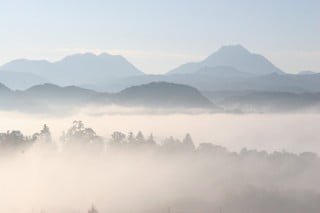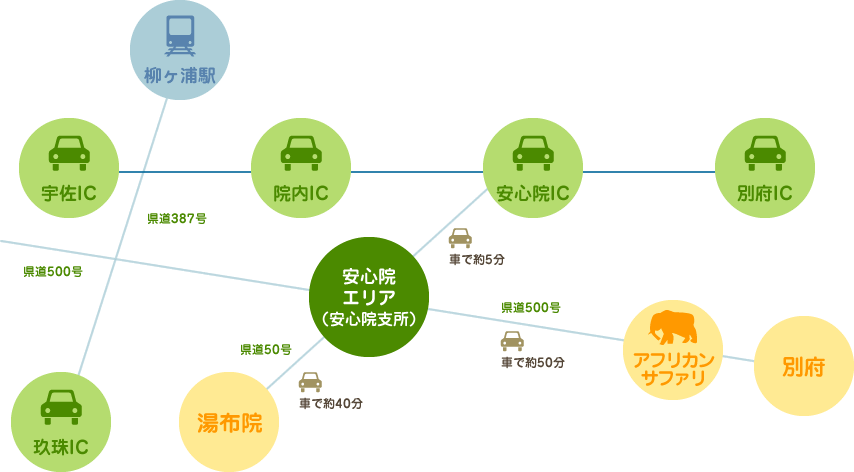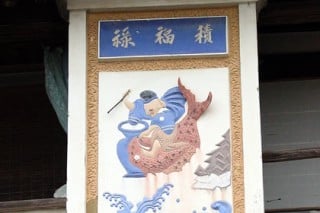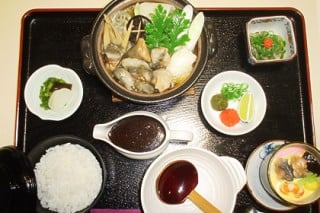"Usa Yujo Map" PDF download (3434KB) |
Information on past events is also posted.
Ajimu Tidbits

Ajimu Basin in the morning mist Ajimu Basin in the morning mist
Ajimu is located in the center of an area with the name "In" along with Yufuin to the south and Innai to the west, and also borders Beppu City, Kitsuki City, and Kusu Ujimachi. The topography is a sloping ridge extending from the Yufu/Tsurumi mountain range to the south, and a plateau has developed in the area that touches the lake basin. The Tsubogawa River and the Fukamigawa River, which are made up of large and small tributaries, flow into the basin from the south and join the Sada River on the north side to form the Ekidate River.
As for place names, it is helpful to refer to the "Engishiki" of the Heian period, which mentions Anbuki Station among the names of ancient stations leading from Buzen Kokufu (Miyako Town, Fukuoka Prefecture) to Bungo Kokufu (Oita City). Anzai Fukuin is thought to have originally had two characters: 西(shi) and 復 (bu), and also assumes that there was a warehouse in the basin lined with storehouses for storing rice collected as tax. There is a theory that it changed to Ajimu.
In addition, nationally valuable animal fossils such as the Japanese elephant, fish, amphibians, and mammals have been discovered in strata dating back approximately 4-3,000,000 years ago within the basin.
On the hills and plateaus overlooking the basin, there are ancient ruins as well as Tsumagaki Shrine and Mikami Shrine, which are one of the eight shrines of Usa Shrine. Tsumagaki Shrine is a shrine built by Usazuhiko and Usazuhime to entertain the emperor when Emperor Jimmu's party headed from Hyuga to Nara stopped in Usa. It is also a special place.
The mountainous area is included in the nationally designated scenic spot Yabakei, and includes scenic spots such as Sen-no-Iwa, Higashi-Shiiya, and Fukino Falls. In addition, during the Meiji and Taisho eras, silkworm production was popular along with rice and wheat. The trowel paintings that remain in old folk houses testify to the richness of the past.
The former mulberry fields were turned into vineyards and became Ajimu's new industry, including wine production.
In addition, the green tourism movement, where people enjoy vacations in rural areas, is famous as a pioneer nationwide. Additionally, Kyushu's only natural animal park, agricultural culture park, and family travel village have been built on the vast land, which are enjoyed by many tourists.
As for place names, it is helpful to refer to the "Engishiki" of the Heian period, which mentions Anbuki Station among the names of ancient stations leading from Buzen Kokufu (Miyako Town, Fukuoka Prefecture) to Bungo Kokufu (Oita City). Anzai Fukuin is thought to have originally had two characters: 西(shi) and 復 (bu), and also assumes that there was a warehouse in the basin lined with storehouses for storing rice collected as tax. There is a theory that it changed to Ajimu.
In addition, nationally valuable animal fossils such as the Japanese elephant, fish, amphibians, and mammals have been discovered in strata dating back approximately 4-3,000,000 years ago within the basin.
On the hills and plateaus overlooking the basin, there are ancient ruins as well as Tsumagaki Shrine and Mikami Shrine, which are one of the eight shrines of Usa Shrine. Tsumagaki Shrine is a shrine built by Usazuhiko and Usazuhime to entertain the emperor when Emperor Jimmu's party headed from Hyuga to Nara stopped in Usa. It is also a special place.
The mountainous area is included in the nationally designated scenic spot Yabakei, and includes scenic spots such as Sen-no-Iwa, Higashi-Shiiya, and Fukino Falls. In addition, during the Meiji and Taisho eras, silkworm production was popular along with rice and wheat. The trowel paintings that remain in old folk houses testify to the richness of the past.
The former mulberry fields were turned into vineyards and became Ajimu's new industry, including wine production.
In addition, the green tourism movement, where people enjoy vacations in rural areas, is famous as a pioneer nationwide. Additionally, Kyushu's only natural animal park, agricultural culture park, and family travel village have been built on the vast land, which are enjoyed by many tourists.

Recommended Spots

Kotee
Trowel-e can be seen throughout the Ajimu area, but the Koe-e street in the Shimoge/Oshikita area is packed with excellent works, including those that have been relocated. On the left bank of the Fukami River are Mikami Shrine and Shimoichi Magaibutsu, and on the plateau there is a popular family travel village and Ajimu Winery. The view of the basin from this plateau with mountains such as Mt. Yufu in the background is spectacular.
In the basin of the Tsubo River, the Kyushu Natural Zoological Park African Safari is located in the highland area bordering Beppu, and Higashishiya Falls is located downstream. Also popular are the Magaibutsu in Narumoto and the Hell of Paradise at the ruins of Keishoji Temple.
In the Fukami River basin, we recommend Fukino Falls, Nankoji Nio statue in the Matsumoto area (Newt Valley), Sen no Iwa, Tsumagaki Shrine, Ryuo Castle Ruins, Fukami Five-storied Pagoda, and Omura Retro Street. In the Sada River basin, there are Kyushu Natural Zoological Park African Safari, Oita Agricultural Culture Park, Yamagura no Ichiigashi (Otoshi Shrine), Sada Retro Street, and Kyoseki, a popular power spot.
In the basin of the Tsubo River, the Kyushu Natural Zoological Park African Safari is located in the highland area bordering Beppu, and Higashishiya Falls is located downstream. Also popular are the Magaibutsu in Narumoto and the Hell of Paradise at the ruins of Keishoji Temple.
In the Fukami River basin, we recommend Fukino Falls, Nankoji Nio statue in the Matsumoto area (Newt Valley), Sen no Iwa, Tsumagaki Shrine, Ryuo Castle Ruins, Fukami Five-storied Pagoda, and Omura Retro Street. In the Sada River basin, there are Kyushu Natural Zoological Park African Safari, Oita Agricultural Culture Park, Yamagura no Ichiigashi (Otoshi Shrine), Sada Retro Street, and Kyoseki, a popular power spot.
Tourism Initiatives

Softshell turtle dish
The Ajimu area, which is blessed with beautiful natural scenery, has actively implemented tourism promotion projects since the old town era, and many large-scale tourist facilities have been built by the public and private sectors. In addition, thanks to the green tourism movement that we pioneered nationwide, we are now able to see the future of tourism. In order to make more tourists aware of Ajimu's charms, collaboration with nearby tourist destinations is necessary. In particular, the fact that Yufuin, Ajimu, and Innai share the same character means that customers visiting Yufuin can experience waterfalls, valleys, history, and other attractions that Yufuin does not have, creating a new and fresh travel experience. We can provide you with entertainment.
With the birth of Shin-Usa City, we are now able to offer tourism that includes everything from the mountains to the sea in one package. If a rural experience is green tourism, a fishing village experience is marine blue tourism. While the three locations collaborate horizontally, Blue Tourism collaborates vertically. From now on, you can enjoy sightseeing in Usa, with Usa Jingu as its center, traveling to the sea and mountains.
Ajimu's local cuisine is soft-shelled turtle cuisine. Kenjiro Kinoshita, a politician and culinary expert from Ajimu, praised it in his best-selling book "Bimikyushin," calling it the ultimate gourmet food. Coupled with the health food boom, soft-shelled turtle dishes are once again attracting attention.
With the birth of Shin-Usa City, we are now able to offer tourism that includes everything from the mountains to the sea in one package. If a rural experience is green tourism, a fishing village experience is marine blue tourism. While the three locations collaborate horizontally, Blue Tourism collaborates vertically. From now on, you can enjoy sightseeing in Usa, with Usa Jingu as its center, traveling to the sea and mountains.
Ajimu's local cuisine is soft-shelled turtle cuisine. Kenjiro Kinoshita, a politician and culinary expert from Ajimu, praised it in his best-selling book "Bimikyushin," calling it the ultimate gourmet food. Coupled with the health food boom, soft-shelled turtle dishes are once again attracting attention.
